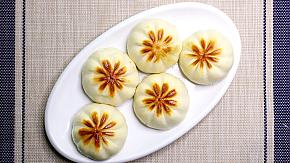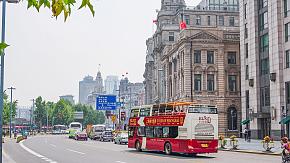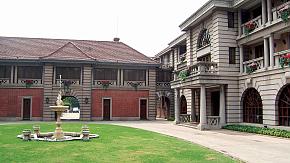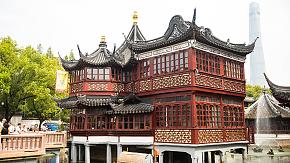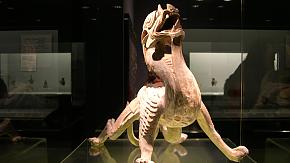Top 10 Shanghai Dishes You Must Try
Compared to other regional cuisines in China, Shanghainese cuisine tends to have a sweeter flavor profile. The cooking style emphasizes the use of rich oil and dark soy sauce. "Rich oil" refers to the generous use of oil, which enhances the texture and aroma of the dishes, while "dark soy sauce" is a blend of soy sauce, sugar, and various seasonings, simmered to create a deep color and rich, unique taste. This perfect combination of oil and sauce makes the food more flavorful and visually appealing.
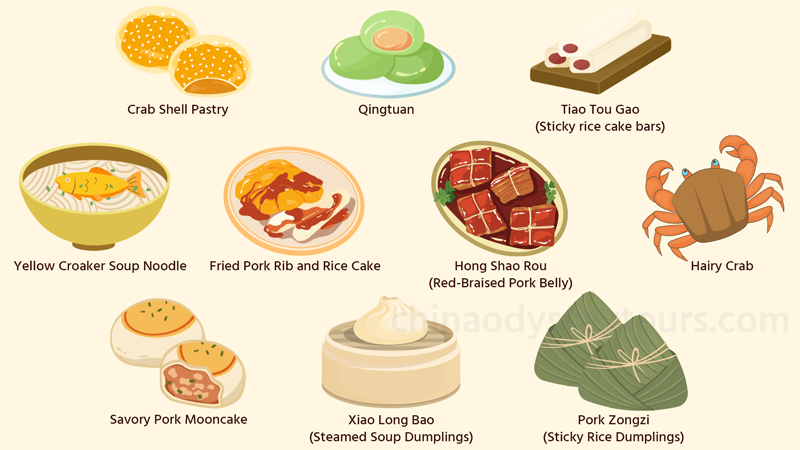 Top Shanghai food your must try
Top Shanghai food your must try
Dishes like Braised Pork Belly (Hong Shao Rou) and Rice Cake with Pork Ribs are classic examples. They deliver a noticeable sweetness at first bite, followed by a savory, umami taste upon closer savoring.
Shanghai snacks also tend to be on the sweeter side and often incorporate glutinous rice. Popular examples include Qingtuan (glutinous rice dumplings filled with sweet or savory fillings) and Tiao Tou Gao (steamed glutinous rice cake). Some snacks feature meat while maintaining a fresh and savory taste, such as Savory Pork Mooncakes and Pork Zongzi (sticky rice dumplings).
With these characteristics in mind, let's explore some must-try foods in Shanghai!
Xiao Long Bao (Steamed Soup Dumplings)
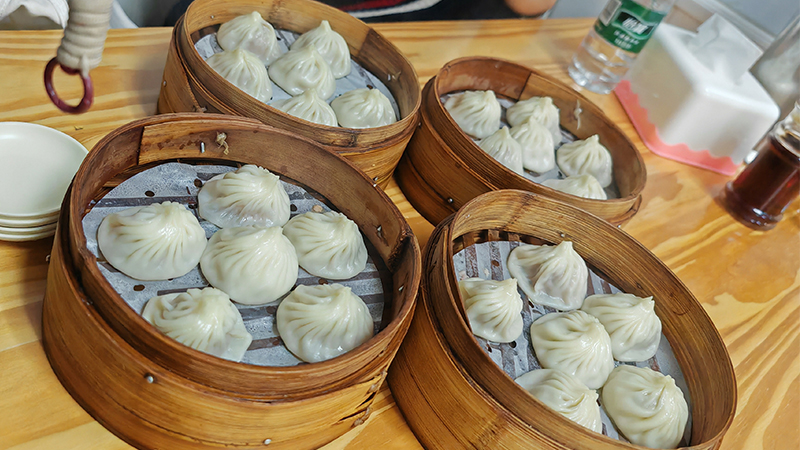 Xiao Long Bao
Xiao Long Bao
Shanghai Xiaolongbao (soup dumplings) are known for their thin skin, generous filling, and rich, flavorful broth. You can easily find Xiaolongbao at local bun shops throughout the city, where they are typically steamed fresh to order, resulting in a tender, juicy bite. The most classic Xiaolongbao are sold in portions of around six, with each bun measuring about 4 to 5 centimeters (about 1.5 to 2 inches) in diameter.
A gentle reminder for you: despite the size of the bun being small, don't be tempted to pop a whole bun into your mouth at once because the hot broth inside may scald your mouth. The recommended way to enjoy them is to let them cool a bit, then gently bite the skin and sip the broth, and finally eat the rest of the bun.
Where to Eat
One of the best places to try these soup-filled Xiaolongbao is Nanxiang Steamed Bun Restaurant. Originally from Nanxiang Town in Shanghai, this iconic eatery now has branches across the city. You can find a popular location at Yuyuan Bazaar, making it a perfect stop while exploring the area.
In addition to the traditional steamed Xiaolongbao, there's also a pan-fried version, which is a specialty of Yang's Dumpling. The pan-fried buns have a crispy, golden bottom while still locking in the delicious broth inside. One bite delivers a satisfying crunch followed by a burst of flavorful soup. Yang's Dumpling has numerous branches, often located in large shopping malls. You'll also find them at Shanghai's airports and train stations, making it a convenient option for a quick bite during transit or before departure.
Qing Tuan
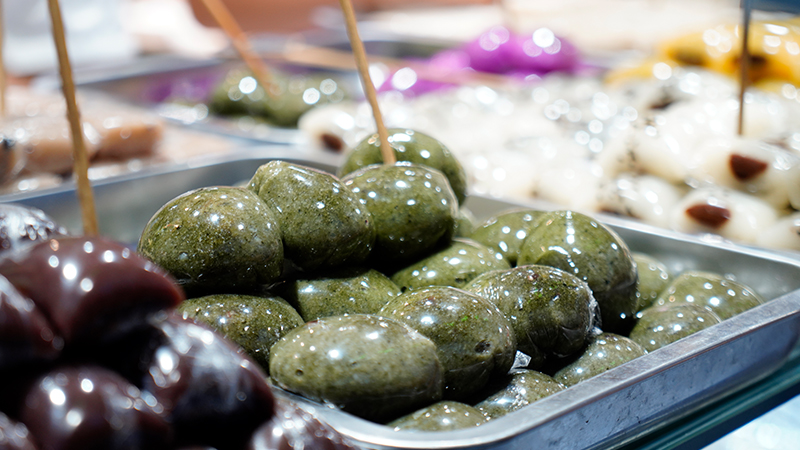 Qing Tuan
Qing Tuan
Qing Tuan was originally a festive food traditionally eaten during the Qingming Festival, which usually falls on April 5th. However, due to its popularity among Shanghai residents, it has become a common snack available year-round. Qing Tuan is made by cooking glutinous rice and mixing it with mugwort leaves, then pounding the mixture into a green dough. The dough is divided into small portions, filled with various fillings, and steamed until ready to eat.
The traditional fillings for Qing Tuan are peanut and sesame or red bean paste, and the outer layer, infused with mugwort, has a slightly bitter, herbal flavor. What makes Shanghai's Qing Tuan stand out is its variety of innovative and unique fillings. While some shops still offer traditional flavors, many have introduced modern options like cheese, matcha, and fruit fillings such as mango or peach. For those who prefer savory options, fillings like salted egg yolk with pork floss or vegetable with minced pork are also popular.
Where to Eat
When it comes to trying Qing Tuan in Shanghai, some of the best places are time-honored brands like Shen Dacheng (沈大成), Wufangzhai (五芳斋), and Xinghualou (杏花楼). Qing Tuan can be sold individually, usually priced at around 5 RMB (approximately 0.7 USD) per piece, or in sets of six, with prices ranging from 30 to 50 RMB (about 4.3 to 7.1 USD). For the best experience, you can ask the shop to warm them up, making the texture softer and the flavor more aromatic.
Hong Shao Rou(Red-Braised Pork Belly)
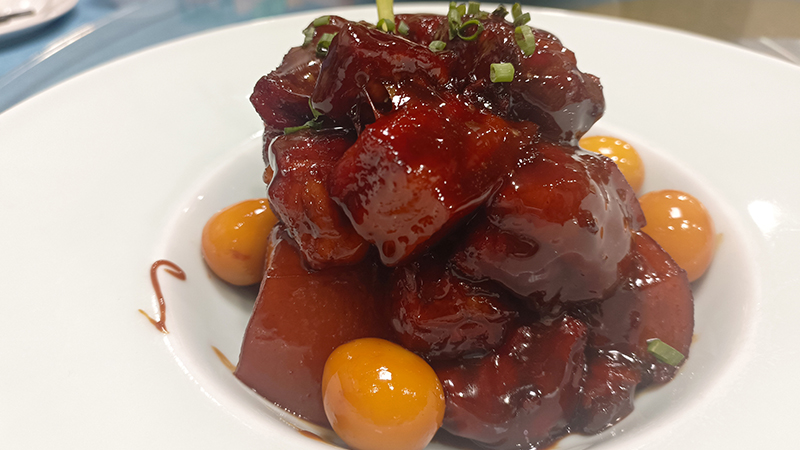 Hong Shao Rou
Hong Shao Rou
Where to Eat
The most recommended restaurant for Hong Shao Rou is Old Jesse (老吉士), a small and family-style restaurant known for serving one of the best traditional Hong Shao Rou in Shanghai. Be sure to make a reservation as it's quite popular and the seats are limited.
Savory Pork Mooncake
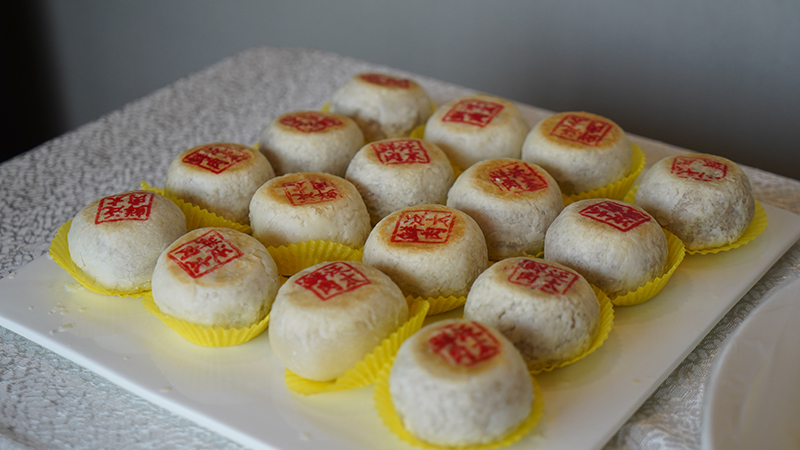 Savory Pork Mooncake
Savory Pork Mooncake
Savory Pork Mooncake, also called fresh meat mooncake. Traditionally, it refers to the savory version of the traditional Chinese mooncake. Unlike the sweet mooncakes enjoyed during the Mid-Autumn Festival, this Shanghai specialty is filled with juicy pork mince and encased in a flaky, golden pastry crust.
These mooncakes are typically baked fresh and served hot, with the pork filling often seasoned with soy sauce, ginger, and sometimes a touch of sugar for balance. The contrast between the crisp, buttery crust and the flavorful, tender meat filling makes it a beloved snack in Shanghai. Thus, even outside of the Mid-Autumn Festival holiday, the sales of fresh meat mooncakes remain high.
Where to Eat
The most recommended stores to buy these mooncakes are Shen Dacheng(沈大成) and Guang Ming Cun (光明邨). Generally, they are sold by the box for convenience, with each box containing six mooncakes, priced around 5 to 6 RMB per piece.
Hairy Crab
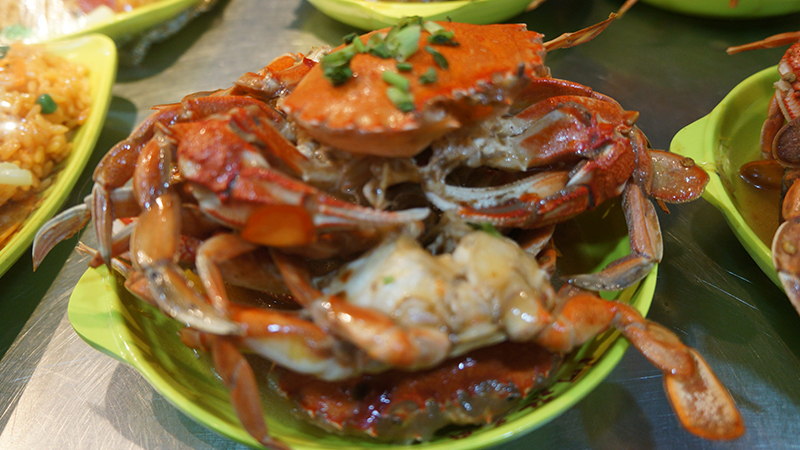 Hairy Crabs
Hairy Crabs
If you're seafood lover, don't miss the hairy crab when you travel to Shanghai. Hairy crab (大闸蟹), also known as Chinese mitten crab, is a freshwater crab famous for its rich, buttery roe and tender meat. The crab is highly prized in Chinese cuisine, especially for its roe, which turns golden-orange when cooked and has a creamy, umami flavor. The best time to enjoy hairy crab in Shanghai is during its peak season, from late September to early December. This period corresponds to the crab's natural breeding season when the meat is at its juiciest, and the roe is most abundant and flavorful.
For the most part, people steam the hair crabs to preserve their natural flavor. These crabs are often served with a dipping sauce made of ginger and black vinegar, which balances the crab's richness and adds more flavors to the dish.
Where to Eat
Some of the best places to try it in Shanghai include time-honored restaurants like Cheng Long Hang (成隆行) and Wang Bao He (王宝和). In addition to whole crabs, you can also try dishes made with crab meat and crab roe at some restaurants. Popular options include crab roe noodles and crab roe soup dumplings. For example, the crab roe noodles and soup dumplings at Yuxingji are highly recommended for their rich, savory flavors.
Yellow Croaker Soup Noodle
The yellow croaker noodles is a traditional Shanghai noodle dish in Shanghai and Zhejiang Province. It's known for its delicate, flavorful broth and tender fish. The dish is typically made with yellow croaker (also called yellow corvina), a prized fish in Chinese cuisine for its soft, flaky flesh and rich flavor.
The yellow croaker is either fried or poached and served over a bed of thin wheat noodles in a white, savory broth. The soup is often made with fish bones and enhanced with ingredients like ginger, scallions, and sometimes pork lard to add depth of flavor.
Where to Eat
The best places to enjoy the yellow croaker noodles in Shanghai is A Niang Mian Guan(阿娘面馆). Pay 30 RMB (about 4.22 USD) and you will get a full bowl of noodles. Apart from the noodles, the side dishes in this restaurant are also worth trying, such as shredded pork with pickled vegetables. It's a chained restaurant and you can find multiple branches across Shanghai, including Yu Garden or Xintiandi areas.
Fried Pork Rib and Rice Cake
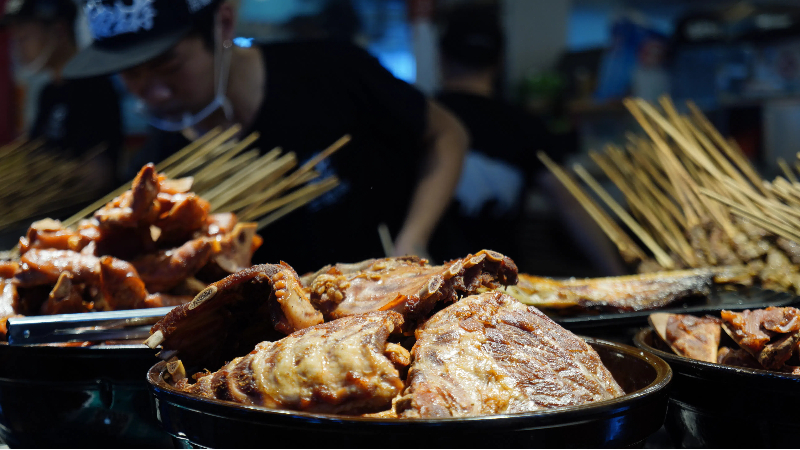 Fresh-made fried ribs
Fresh-made fried ribs
It's a popular street food in Shanghai, beloved by younger generations. This dish features deep-fried pork ribs that are tender on the inside and crispy on the outside, served alongside or stir-fried with rice cakes, which are made from glutinous rice flour. The sauce of this dish is sweet, which is made from soy sauce, sugar, and wine.
Where to Eat
Compared to other dishes, fried pork ribs with rice cakes are easier for Westerners to enjoy, as the texture is similar to fried chicken, except it's made with pork ribs. If you're interested, you can try a serving at Yang's Dumpling (小杨生煎), Old Jesse (老吉士), or Xiandelaizhai (鲜得来).
Pork Zongzi (Sticky Rice Dumplings)
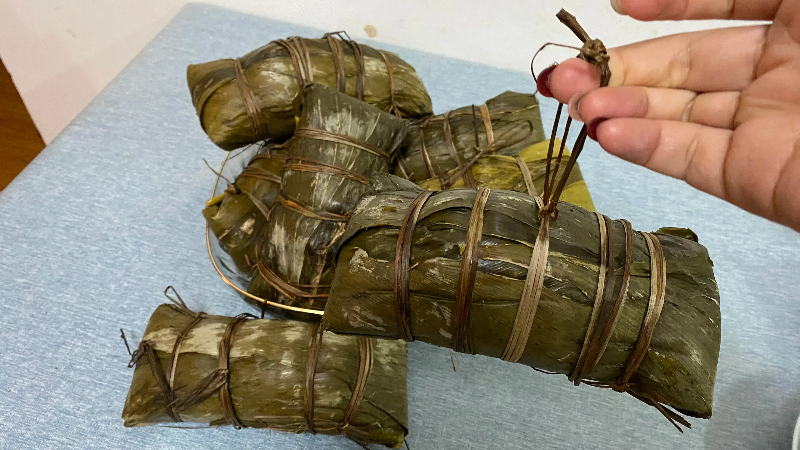 Pork Zongzi wrapped in bamboo leaves
Pork Zongzi wrapped in bamboo leaves
Similar to Qing Tuan, Zongzi is also a traditional festive food, typically enjoyed during the Dragon Boat Festival. Around this time, street food vendors across Shanghai start selling zongzi. The most common type in Shanghai is the savory pork zongzi, usually shaped like a pyramid.
This type of zongzi is primarily made with glutinous rice, pork, and mung beans. Some vendors may enhance the flavor and distinguish their offerings by adding ingredients like salted egg yolk, dried shrimp, scallops, or mushrooms.
Freshly made pork zongzi are often sold hot, and it's best to enjoy them while they're warm. Alternatively, vacuum-sealed zongzi are also available, which are convenient for transport and have an extended shelf life of two to three days.
Where to Eat
Recommended shops to try zongzi in Shanghai include Lufang Zongwang (璐坊粽王) and Xinghualou (杏花楼). All of them are chained stores with branches everywhere in Shanghai. Prices vary depending on the filling, typically ranging from 5 to 10 RMB per zongzi (approximately 0.7 to 1.42 USD).
Crab Shell Pastry
The crab shell pastry is a traditional Shanghai pastry. Its Chinese name, 蟹壳黄, literally means "golden crab shell" due to its round and golden-brown appearance that resembles a crab shell. However, the ingredients of this pastry don't contain crab. It's a type of baked or pan-fried pastry with a flaky and crispy crust made from layers of dough and lard.
There are two different kinds of carb shell pastries: the savory one and the sweet one. The savory crab shell pastries have meat as fillings, such as pork mince or spiced pork floss, with few scallions as flavor enhancer. The sweet crab shell pastries are filled with red bean paste, sesame paste, or simply just sugar.
Where to Eat
Crab Shell Pastry is a popular snack in Shanghai. You can find it in some local food stores, such as Wang Jia Sha (王家沙). They are usually sold by the box, with each box containing six pieces and priced between 16 to 20 RMB (about 2.3 to 2.81 USD).
Tiao Tou Gao (Sticky Rice Cake Bars)
Tiao Tou Gao (条头糕) is a traditional Shanghai-style glutinous rice cake. It is a simple yet beloved local snack, known for its soft, chewy texture and subtly sweet flavor.
The cake is typically made from glutinous rice flour, steamed, and flavored with ingredients like red bean paste, with osmanthus syrup, or sesame as topping. It is usually served warm and is a popular breakfast or afternoon snack.
Where to Eat
You can find Tiao Tou Gao in some traditional pastry shops, local markets, and some snack shops. Here are some recommended shops: Shen Dacheng(沈大成) and Guang Ming Cun (光明邨).
Tips for Eating on Your Shanghai Tour
- Book your meal before starting your day. The stores and restaurants we recommended are quite popular, so you may need to wait in line for a while if you don't book in advance. For main meals, it's best to reserve a day ahead, while for snacks, booking 2 to 3 hours in advance should be sufficient.
- Travel with us and you won't worry about allergies. If you have celiac disease or food allergies, you may need to let the restaurant know about what you don't eat. Our guides can communicate with restaurants to ensure they don't use ingredients that may trigger your allergies, or recommend some dishes based on your personal preferences.
All in all, Shanghai is a city with a rich and diverse culture, offering countless views and food waiting to be explored. Write to trip@odynovotours.com for a personalized itinerary for a Shanghai tour.
Related Posts You May Like
What Our Clients Say
"Great Customized Service", "Trip of A Lifetime", "Exceed All Expectations"

